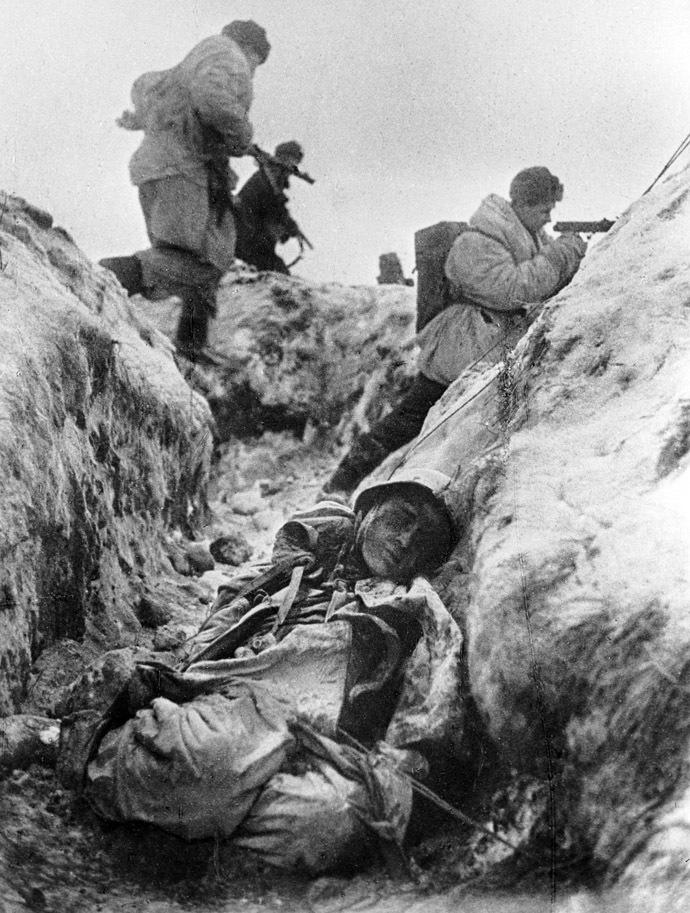1,418 days in hell: Soviet Union's Great Patriotic War in pictures

On May 9, Russia celebrates the defeat of the Nazi forces in the Great Patriotic War (WWII), which cost the country over 26 million of lives. RT looks back at the most significant events of the bloodiest war in the history of humanity.
The Great Patriotic War began at 4 am on June 22, 1941, when Nazi Germany attacked the Soviet Union, breaking the 1939 Non-Aggression Treaty.

On the first day of the, the Hitler Army bombed Sevastopol, Kiev, Zhitomir, Kaunas and other cities. The Soviet Union lost about 1,200 aircraft: 300 were destroyed in aerial battles and 900 were eliminated on the ground.

The Presidium of the Supreme Council of the USSR issued a decree on mobilization, beginning June 23, of all the enlisted citizens born between 1905 and 1918. In total, The Red Army conscripted over 34 million people during the war, with 850,000 from Moscow alone.

Moving further to the East, Nazi troops eliminated thousands of Soviet towns, villages, plants, factories, cultural and historic monuments. Only in Belarus, over 200 towns and 9,200 villages were burnt or destroyed.

The Battle for Moscow – which lasted from late autumn of 1941 to mid-spring of 1942 - marked the first major defeat of Nazi Germany in WWII. “When I am asked what event in the war impressed me most, I always say: the Battle of Moscow,” Soviet Marshal Georgy Zhukov wrote in his memoirs.

The Soviet victory in the fight for Moscow was of moral and strategic importance. Both sides suffered tremendous losses: the USSR lost 1.8 million people while the German Wehrmacht – over 580,000.

By late September 1941, Nazi troops had taken control over Smolensk, Kiev, started a siege of Leningrad and approached Crimea.

For Hitler, capturing the peninsula on the Black Sea, Crimea was strategically important to prevent Soviet air raids on Romanian oil fields and get access to the Caucasus region.

The town of Kerch, in the east of Crimea, fell to the Nazi onslaught in November 1941. The key Black Sea port city of Sevastopol was invaded following months of bloody fighting in July 1942. The peninsula was retaken by the Red Army on April 18, 1944. Sevastopol was liberated on May 9, 1944.

The epic Battle of Stalingrad became the turning point in World War II, and consequently led to the defeat of the Nazi army. The bloody confrontation lasted between August 1942 and February 2, 1943, claiming the lives of nearly 2 million people on both sides.

On January 27, 1944, the Soviet Army lifted the blockade of Leningrad that had been besieged by the Nazi forces for 872 days. The siege claimed the lives of over a million people, who died of starvation, cold and in the extensive bombing of the city.

On June, 6, 1944 the Western Allies landed in Normandy, opening the long-awaited "Second Front" in the fight against the Nazi Germany. On June 23, the Soviet Union launched mass-scale offensive Bagration, which resulted in the liberation of Belarus.

The final battles of the Great Patriotic War and of the European Theatre of the WWII took place in April-May 1945. On May 8 (at 00:43, May 9 Moscow time), Germany surrendered.

On May 1, 1945, Soviet soldiers placed the red Soviet Victory Banner over the Reichstag building in Berlin, symbolizing the final collapse of Nazi Germany.

You can share this story on social media:
Dear readers! Thank you for your vibrant engagement with our content and for sharing your points of view. Please note that we have switched to a new commenting system. To leave comments, you will need to register. We are working on some adjustments so if you have questions or suggestions feel free to send them to feedback@rttv.ru. Please check our commenting policy















